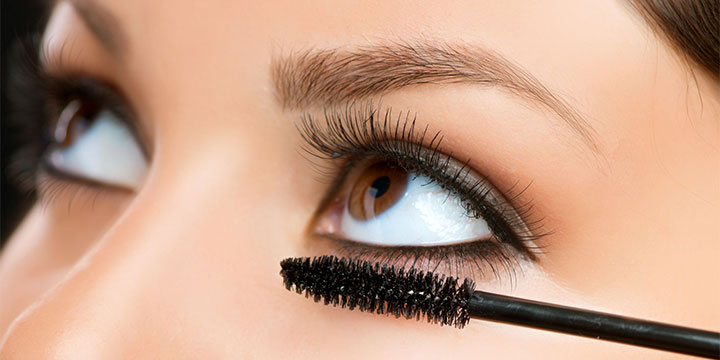Do your eyes feel red, itchy and dry on a regular basis? If so, you could be having an adverse reaction to one or more of the ingredients in your cosmetic products, causing symptoms of dry eye syndrome. The following five makeup ingredients commonly cause eye allergies and dry eye, so try to avoid them whenever possible for more comfortable and clearer eyes.
Carnauba Wax
Carnauba wax is commonly found in mascaras and eyeliners to create a firmer, waterproof product. However, using carnauba wax and other types of wax on your eyelashes and near your eyes could cause the oil glands at the base of your eyelashes to become clogged [1]. This can result in dry eye, as oil secretions are necessary in order to keep your eyes properly lubricated.
To avoid using mascaras and other makeup products that contain carnauba wax, opt for non-waterproof alternatives, or simply use a clean lash curler without mascara.
Heavy Metals

Heavy metals such as nickel, chrome and even gold and silver have been shown to be irritating to the skin and eyes, which is why many people cannot wear certain types of jewelry [2, 3]. These same metals can also be found in many makeup products, including green and metallic eyeshadow and eyeliners, as well as makeup brushes themselves. Exposure to heavy metals in eye makeup could result in dry, red, itchy or watery eyes.
Sodium Lauryl Sulfate
Sodium lauryl sulfate, or SLS, is another ingredient that is commonly found in many cosmetic, skin care and household products, yet it is a known skin and eye irritant [4]. It is found in so many different types of products that your skin and eyes can be exposed to a fairly high amount, based purely on the fact that it is likely contained in most of your daily used products.
Bismuth Oxychloride

Bismuth oxychloride is one of the most popular ingredients used in many mineral makeup powders, as well as other cosmetic products used to create a subtle shimmering effect on the skin or eyelids. However, many people are sensitive to this ingredient, which can result in skin and eye dryness, redness and irritation.
Mica
Mica is another ingredient that is often found in mineral powders and makeup items. It also happens to be used in the production of various construction materials, such as roofing shingles, wallpaper and paint. Thus, it’s probably not surprising that mica can cause dry, irritated eyes when used in eyeshadows, eyeliners and facial powders.
Makeup Tips to Alleviate Dry Eye
If you’re having trouble managing dry eye syndrome or other common signs of eye allergies such as redness, watering or swelling, consider switching to hypoallergenic cosmetic products. Although it’s also a good idea to be on the lookout for the five ingredients listed above, they may not always necessarily be included on the ingredient list of every product that contains them.
In addition, make sure you’re fully removing your makeup every night before going to bed. Rely on a gentle, yet highly effective cleansing product that is designed for use on your eyelids and near your eyes.

If you’re new to cleansing your eyes as part of your regular skin care routine, you could benefit from trying the Cliradex Starter Kit, which includes Cliradex Light Foam and Cliradex Towelettes. These products are the only commercially available eye area cleansers that contain isolated 4-Terpineol, the most efficient compound found in tea tree oil for eliminating demodex eyelash mites that can contribute to dry eye symptoms [5].
The Bottom Line
Don’t let makeup allergies get in the way of your eyes looking and feeling their best. If you can’t seem to find the culprit behind your dry, red and uncomfortable eyes, you may need to take a closer look at what’s inside your cosmetic products.
[1] Fox News Health
[2] International Journal of Environmental Research and Public Health
[3] Mayo Clinic




